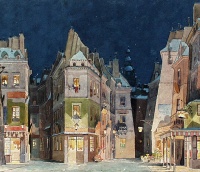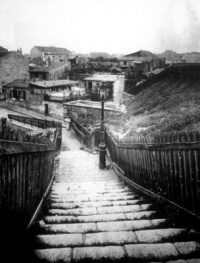Dérive
From The Art and Popular Culture Encyclopedia
|
The dérive (with its flow of acts, its gestures, its strolls, its encounters) was to the totality exactly what psychoanalysis (in the best sense) is to language. Let yourself go with the flow of words, says the psychoanalyst. He listens, until the moment when he rejects or modifies (one could say detourns) a word, an expression or a definition. The dérive is certainly a technique, almost a therapeutic one. But just as analysis unaccompanied with anything else is almost always contraindicated, so continual dériving is dangerous to the extent that the individual, having gone too far (not without bases, but...) without defenses, is threatened with explosion, dissolution, dissociation, disintegration. And thence the relapse into what is termed ‘ordinary life,’ that is to say, in reality, into ‘petrified life.’ In this regard I now repudiate my Formulary’s propaganda for a continuous dérive. It could be continuous like the poker game in Las Vegas, but only for a certain period, limited to a weekend for some people, to a week as a good average; a month is really pushing it. In 1953-1954 we dérived for three or four months straight. That’s the extreme limit. It’s a miracle it didn’t kill us” (Ivan Chtcheglov, excerpt from a 1963 letter to Michèle Bernstein and Guy Debord, reprinted in Internationale Situationniste #9, p. 38). "to dérive was to notice the way in which certain areas, streets, or buildings resonate with states of mind, inclinations, and desires, and to seek out reasons for movement other than those for which an environment was designed. It was very much a matter of using an environment for one's own ends, seeking not only the marvellous beloved by surrealism but bringing an inverted perspective to bear on the entirety of the spectacular world." -- The Most Radical Gesture: The Situationist International in a Post Modern Age, 1992, Sadie Plant. |
|
Related e |
|
Featured: |
In psychogeography, a dérive is a concept and praxis meaning an aimless walk, probably through city streets, that follows the whim of the moment. Dérive is French for drift.
It is an unplanned journey through a landscape, usually urban, on which the subtle aesthetic contours of the surrounding architecture and geography subconsciously direct the travellers, with the ultimate goal of encountering an entirely new and authentic experience. In Internationale Situationniste #1 (June 1958), Situationist theorist Guy Debord defines the dérive as "a mode of experimental behavior linked to the conditions of urban society: a technique of rapid passage through varied ambiances."[1]
History
The concept of the dérive has its origins in the Letterist International of the 1940s, an artistic and political collective based in Paris, where it was a critical tool for understanding and developing the theory of psychogeography, defined as the "specific effects of the geographical environment (whether consciously organized or not) on the emotions and behavior of individuals."[2] The dérive, an unplanned tour through an urban landscape directed entirely by the feelings evoked in the individual by their surroundings, served as the primary means for mapping and investigating the psychogeography of these different areas.
The dérive continued to be a critical concept in the theory of the Situationist International, the radical group of avant-garde artists and political theorists that succeeded the Letterist International, emerging in the 1950s. For the situationists, the dérive is the primary technique for exploring an urban landscape's psychogeography and engaging in new experiences. According to situationist theorist Guy Debord, in performing a dérive, the individual in question must first set aside all work and leisure activities and all their other usual motives for movement and action, and let themselves be drawn by the attractions of the terrain and the encounters they find there.
Dérive is necessary, according to situationist theory, because of the increasingly predictable and monotonous experience of everyday life that workers trudge through in advanced capitalism. The dérive grants a rare instance of pure chance, an opportunity for an utterly new and authentic experience of the different atmospheres and feelings generated by the urban landscape. Debord observes in his Introduction to a Critique of Urban Geography:
- "The sudden change of ambiance in a street within the space of a few meters; the evident division of a city into zones of distinct psychic atmospheres; the path of least resistance that is automatically followed in aimless strolls (and which has no relation to the physical contour of the terrain); the appealing or repelling character of certain places — these phenomena all seem to be neglected. In any case they are never envisaged as depending on causes that can be uncovered by careful analysis and turned to account."
Several groups have adopted the concept of the dérive and applied it in their own form, including many modern organizations, most notably the London Psychogeographical Association and the Providence Initiative for Psychogeographic Studies.
See also
- Unitary urbanism
- Flâneur
- Parkour
- Wanderlust
- Pedestrian
- Lost
- Let's Get Lost
- An artist might advance specifically to get lost
- "Surrealism and the Irrational Embellishment of Paris" by Raymond Spiteri




